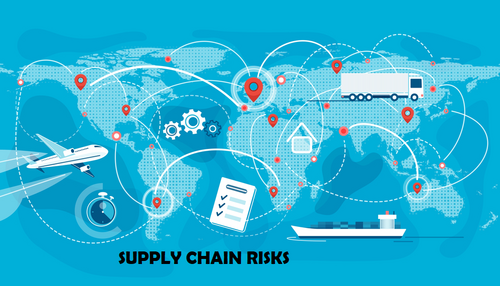Nothing can be more disgraceful for a brand when its popularity is at stake. This mostly happens due to the discrepancies between the raw materials they order and the ones they receive. Supply chain risks need not be ignored, especially when trusting suppliers is becoming hard with time. An organization may suffer cost volatility or payment of non-compliance fines working with an inappropriate supply chain. To prevent substantial financial losses, organizations must keep an eye on every detail of the resources procured from external vendors.

Jump ahead to
What Kind Of Risks To Expect From A Supply Chain?
Organizations need to identify the risks first before they can prevent them. Here, is a categorization of the complexities that can be caused within the organization’s supply chain if not watched closely.
Legal
An organization may become legally challenged if it has unknowingly compromised its product quality. Supply chain irregularities often lead to such issues if not paid heed to. The organization may end up facing allegations on the grounds of civil law violations. Failing to meet a product’s contract in terms of consumer requirements and expectations often leads to such consequences.
Financial
Delays in receiving the manufacturing components from the supply chain vendors obstruct the workflow. As a result, the manufacturing company is unable to complete the product and deliver it to the market on time. Low-quality resources from the suppliers can make a produced good defective thereby, making it undergo constructive change. This adds to the organization’s expenses and exceeds its budget.
Environmental hazards
Supply chain vendors often compromise the quality of products while providing them to a manufacturer. This can even destroy an organization’s compliance with environmental policies. Harmful production materials release pollution-causing wastes detrimental to the natural environment.
Safety hazards
Sub-standard products may get delivered by the supply chain in the absence of a risk management system. There is a high probability of workplace injury or allergy for the employees while physically contacting such materials.
What Are The Three Stages Of The Supply Chain Risk Management?
Supply chain management is an ongoing process that comprises the following three stages:
- Identification – Detecting and categorizing the risks related to resource procurement is the first step. It is necessary to continue the supervision of such risks.
- Assessment – It is necessary to analyze the impact of every such risk on a business’s profitability and sales.
- Mitigation – This stage encompasses the planning actions for preventing and reacting to risks.
How To Keep Supply Chain Risks At Bay?
Here are a handful of preventive actions that are highly effective in supply chain risk management.
Familiarity
An organization needs to communicate with supply chain vendors and select the best in business. For this reason, certain factors need to be confirmed. Firstly, suppliers must have records of meeting the terms of contracts with their previous manufacturers. Secondly, they must not engage in conflicts with the organization but peacefully negotiate, instead. Thirdly, a supply chain must have vendors that function only in the manufacturing organization’s best interests. These three conditions are essential for the long-term selection of a supply chain. Unnecessary changing of supply chain activities isn’t advisable. It takes a long for a strong bond to grow between the two parties.
Management
Managing the supply chain vendors is the key to preventing risks. An organization needs to implement a well-planned procurement process to ensure that vendors meet the former’s demands. These demands are related to the cost and quality of the materials sourced from suppliers. Scrutiny of the supplier’s operations and business model is required to identify the latter’s drawbacks if any.
Visibility
Just like production, the supply chain also comprises multiple steps in delivering the ordered products to the manufacturing company. The concerned manufacturing company must ensure that it doesn’t miss the production deadline only due to the delays of suppliers. It must introduce a process for employees to track the delivery of the procured materials. This requires checking on vendors to find out if they are facing issues regarding material availability or transportation. It s also important to analyze if the concerned suppliers are financially stable. This would keep financial issues like corruption and bribery at bay, which may otherwise obstruct production processes.
Backup
Backup suppliers come in handy to prevent production hitches when any of the existing vendors fail to cater. Suppliers may face problems such as low labor and increased demand. So, it is unwise to simply depend on a single network or an individual vendor. Making alternative arrangements will save manufacturing time. Otherwise, it will get delayed if a particular resource fails to arrive at the right time or in its best quality.
Industries have an increasing demand for supply chain management professionals. Aspirants in this domain can climb the ladder of success by attaining the required knowledge and expertise. Learning programs such as Logistics and Supply Chain Management Training are solely fashioned to serve this purpose.



